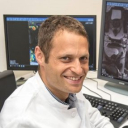
Magnetic resonance imaging and computed tomography are diagnostic procedures that are highly informative, which has made them especially popular. They are used both routinely and in emergencies. However, patients often have a CT scan, rather than an MRI, since the former is more affordable. The average person does not always understand the difference between these two types of imaging studies, and which diagnostic method is more preferable in each particular case.
MRI and CT basic principles
To understand the distinction between CT and MRI, it is important to understand their principles. Both techniques refer to radiology, but work in significantly different ways.
Computed tomography is based on the use of ionizing radiation or X-rays. Issues can absorb X-ray beams depending on their density. As a result, as the rays pass through dense tissues, such as bone elements, the latter do not let them through, while soft tissue do not present any obstacle. Due to this, the obtained images clearly show the bone structure, as well concrements and foreign bodies.
However, a CT scan is not the same as a conventional X-ray study. With the help of X-ray, doctors obtain a single picture with an intended view, whereas CT provides a series of images. This is achieved by emitting the rays from a rotating tube, while stationary sensors pick up the signal. The faster the radiation tube rotates, the more slices can be obtained in a single examination.
MRI is based on the nuclear magnetic resonance of hydrogen atoms, which are found in water molecules. Soft tissues have the greatest amount of fluid, so they are particularly well visualized by MRI. Bones, on the other hand, contain a small amount of water. So, they are poorly shown by such imaging. During the procedure, a magnetic resonance imaging device generates radio electric waves in a constant magnetic field, while the sensors record changes in hydrogen atoms. This produces a slice-by-slice three dimensional pictures.
The main difference between CT and MRI
After studying the principles of action of CT and MRI, it becomes clear what the differences between the two methods of examination are. First of all, they use different devices. Secondly, their purpose is different as well. MRI is better at visualizing soft tissues, but CT is preferable to show solid ones.
As is known, contrast media can be applied in radiology to obtain more information. In this regard, there is also a definite difference between the two types of imaging. In CT iodine-based substances as used as a contrast. It spreads through the body with the bloodstream and makes vessels and soft tissue visible during the scan. This is especially relevant in tumor diagnosis.
In the case of MRI, gadolinium-based agents are injected prior to examination. This also increases the informative value of the examination and makes visible structures that are poorly visualized in the conventional mode.
MRI and CT: comparison summary
| Comparison Area | MRI | CT |
| Physical Basis | Magnet fields / Radio waves | X-rays |
| Duration | 20-60 minutes | 15 minutes |
| Contrast Medium | Gadolinium | Iodine-containing solutions |
| Risks | Gentle and risk-free |
Radiation exposure Possibility of contrast agent sensitivity |
| Advantages |
Good soft tissue imaging (e.g., brain, muscles) Good spatial representation No radiation exposure |
Speed Good bone presentation |
| Disadvantages | Bones are less well represented | Radiation exposure |
When are MRI and CT scans recommended?
Each diagnostic method has its own indications and contraindications. Only the attending physician can determine which exam is the best, taking into account the existing complaints, symptoms, and preliminary diagnosis.
CT indications
CT scans can be performed as part of primary diagnosis as well as to refine the existing one. The following conditions are the main indications for a CT scan:
- cardiovascular system disorders,
- dental diseases,
- abdominal and pelvic organ diseases,
- head injury,
- joint, spine, and bone conditions,
- suspected benign and malignant tumors,
- tuberculosis,
- pneumonia, thorax abnormalities.
Contraindications to taking CT scans
Certain restrictions are associated with ionizing radiation. Other limitations are associated with application of iodine-based contrast agents. Thus, a CT scan is not performed in the following cases:
- During pregnancy, to avoid X-ray exposure.
- If the patient weight is over 120 kg, unless the system is especially designed for a greater weight;
- If there is individual intolerance to iodine.
- In the presence of thyroid disorders.
- During lactation.
- If there is a severe kidney disease.
Indications for MRI
MRI allows better visualization of soft tissues, vessels, tumors, and similar structures. That is, the method is appropriate if it is necessary to examine tissues containing a large amount of water. If necessary, MRI can also study joints, the spine and hollow organs.
This diagnostic modality is indicated in the following cases:
- suspected masses in the brain or spinal cord;
- hormonal disorders;
- central nervous system disorders;
- tumors of benign and malignant nature;
- spinal hernia, osteochondrosis;
- respiratory diseases;
- stroke, vascular and cardiac conditions.
Contraindications to the use of MRI
MRI does not involve radiation exposure, but even so the procedure has its own contraindications. They are associated with the specific magnetic field effect on certain materials. MRI can disrupt the operation of implanted devices, such as:
pacemakers,
hearing aids,
metal clips,
insulin pumps.
Metals can heat up and shift in the magnetic field, so MRI is dangerous if there are foreign metal bodies in the body. In addition, the procedure can break the operation of complex devices. Therefore, patients get a preliminary doctor’s consultation to find out the possible contraindications.
CT and MRI Application areas (a summary)
The following overview summarizes major (but not all) areas of application for the two procedures.
| Area | CT | MRI |
| Lungs | A wide range of applications | In limited cases |
| Muscles and bones | Assessment of bone structures/fracture diagnosis | Assessment of soft tissues/joints/cartilage |
| Abdomen | A wide range of applications | A wide range of applications |
| Chest | A wide range of applications | In limited cases |
| Vessels | A wide range of applications | A wide range of applications |
Differences in MRI and CT scanning
Technically, the procedures are carried out almost identically. Patients are placed on the scanner table. To achieve an accurate result, it is important to ensure complete immobility. For this purpose, straps, rollers, and cushions are used.
Both procedures are different in terms of examination time. MRI generally takes longer than CT. On average, a CT scan takes up to 15 minutes, whereas from 20 to 60 minutes are needed for MRI, the latter concerns very complex issues. Contrast application increases the procedure duration.
How should one prepare for the examination
Getting ready for an MRI and CT scan is almost the same. Most examinations do not require special prior action, lifestyle changes, or a strict diet. Generally, it is advisable to follow the following tips:
- Before the procedure, choose comfortable clothes. Make sure that it does not carry any metals.
- Be sure to bring all necessary paperwork – your ID, doctor's referral, previous study results if available.
- Start taking sedatives in advance if you are too nervous, suffer from claustrophobia, or have a mental disorder. It is also recommended to have someone accompany you.
- Before entering the examination room, leave all metal objects, jewelry, and gadgets in the next room.
It is important to note that certain examination types require specific preparation, i.e.:
- The urinary bladder should be examined when it is full. For this purpose, several glasses of water should be taken two hours before the procedure.
- In pelvis and abdomen examination, it is recommended to adjust your diet 3 days in advance, avoiding foods that cause increased flatulence.
- When contrast is administered in MRI or CT, the patient should fast 3-4 hours before the study.
Please ask for more precise recommendations at your appointment with your primary care physician prior to examination.
Second opinion
There are quite clear criteria for CT and MRI examinations. But the practice does not always meet the standards. For example, if a patient who is indicated for an MRI has an implant of unknown composition. Then there is the possibility that the magnetic field poses a risk, and one has to think about an alternative. Whether a CT scan is such or another diagnostic procedure is better is an important question, and a second opinion can give you the right decision.
Interpretation of MRI and CT scan results is another good reason to ask for an independent evaluation by an expert. Indeed, a correct treatment plan can be drawn only based on solid diagnosis. Merely taking organ pictures and sliced images is not enough. Of major importance is their accurate interpretation. In the case of rare diseases and complex issues, it can be quite difficult to find a specialist to provide a comprehensive assessment of findings. In this situation, a second opinion may become a good solution.
A second opinion can be used if there are doubts about the existing diagnosis and suggested treatment strategy. The appointment can be arranged both offline, in written form, or online with interpreter support.
References
- Use of magnetic resonance imaging, Elizaveta Chabanova, 2014
- Magnetic resonance imaging techniques, Adam R Fisher, 2002
- X-ray computed tomography and magnetic resonance imaging of the cardiovascular system, J A Rumberger, 1993


Comments — 0